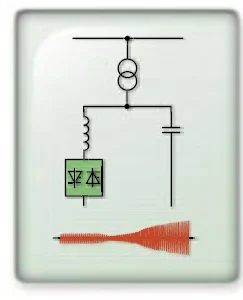دانلود ترجمه مقاله تخصیص بهینه ادوات FACTS سری تحت نفوذ بالای توان باد
| عنوان فارسی |
تخصیص بهینه ادوات FACTS سری تحت نفوذ بالای توان باد در یک محیط بازاری |
| عنوان انگلیسی |
Optimal Allocation of Series FACTS Devices Under High Penetration of Wind Power Within a Market Environment |
| کلمات کلیدی : |
ادوات FACTS سری؛ برنامه ریزی انتقال؛ بهینه سازی دوسطحی؛ بازار برق؛ فرمول بندی مجدد و تجدید ساختار |
| درسهای مرتبط | بهره برداری از سیستم های قدرت؛ انرژی های نو |
| تعداد صفحات مقاله انگلیسی : 11 | نشریه : IEEE |
| سال انتشار : 2018 | تعداد رفرنس مقاله : 45 |
| فرمت مقاله انگلیسی : PDF | نوع مقاله : ISI |
|
پاورپوینت :
ندارد سفارش پاورپوینت این مقاله |
وضعیت ترجمه مقاله : انجام شده و با خرید بسته می توانید فایل ترجمه را دانلود کنید |
1. مقدمه 2. مدل های تزریق توان درFACTS سری 3. فرمول بندی مسئله 4. روش حل مسئله 5. نتایج عددی 6. نتیجه گیری

چکیده – ادوات FACTS سری، یکی از ابزارهای کلیدی برای نفوذ بالای انرژی های تجدید پذیر به دلیل توانایی های آن ها در کنترل پیوسته شارش توان خطوط انتقال، می باشند. این تحقیق یک مدل بهینه سازی دو سطحی را برای بهینه سازی راکتور سری متغیر (VSR) و ترانسفورماتور شیفت فاز (PST) در شبکه انتقال با توجه به نفوذ بالای توان باد ارائه می دهد. مسئله سطح بالا به دنبال به حداقل رساندن هزینه سرمایه گذاری در FACTS سری، هزینه محدود کردن توان باد و از بین بردن بار احتمالی است. مسائل سطح پایین، پاکسازی بازار را تحت سناریوهای عملیاتی مختلف، در نظر می گیرند. نتایج عددی مبتنی بر سیستم 118 باس نشان دهنده عملکرد کارآمد مدل برنامه ریزی شده پیشنهادی و نقش مهم FACTS سری برای تسهیل ادغام توان باد است. مقدمه: انرژی باد به عنوان یکی از مؤثرترین روش های صنعت برق جهت کاهش انتشار گازهای گلخانه ای برای دستیابی به پایداری می باشد. بسیاری از کشورها اهداف خود را برای سطوح نفوذ توان باد در آینده تعیین کرده اند. به عنوان مثال، با توجه به [1]، ظرفیت ژنراتورهای بادی نصب شده در ایالات متحده در سال 2013 به بیش از 61 گیگاوات رسیده است و انتظار می رود که 20٪ و 30٪ از تقاضای برق به ترتیب در سال 2030 و 2050 از توان بادی تامین شود. چالش های فنی زیادی در رابطه با ادغام توان باد به شبکه های قدرت موجود، وجود دارد. یکی از آن ها، متناوب بودن تولید توان باد است که باعث عدم اطمینان بیشتر به شبکه برق شده و منجر به خطرات بالقوه در قابلیت اطمینان و کارایی سیستم می شود [2]. مسئله دیگر ظرفیت انتقال ناکافی برای تحویل مقدار زیادی از توان باد از مناطق دورافتاده به مراکز بار می باشد[3]. یک روش واضح برای افزایش ظرفیت انتقال و تسهیل ادغام توان باد، ساخت خطوط انتقال جدید است. با این وجود، چنین پروژه هایی قابل توجه نیستند، زیرا آن ها معمولا نیاز به هزینه های سرمایه گذاری بالا، زمان ساخت و ساز طولانی و قوانین زیست محیطی سخت گیرانه دارند [4]. یک روش اقتصادی، نصب FACTS بر روی خطوط انتخابی می باشد، که بهره برداری از زیرساخت های انتقال موجود را با تنظیم شارش توان در یک روش انعطاف پذیر تر بهبود می بخشد [5]. علاوه بر این، با توجه به عملیات سریع شان، به عنوان مثال، اغلب در عرض چند دوره فرکانس سیستم، FACTS را می توان به صورت پویا تنظیم کرد تا طبیعت تصادفی توان باد را در بر گیرد. [3]. علاوه بر این، انتظار می رود که FACTS بیشتر مانند دستگاه های [6] با قیمت بسیار پایین تر به زودی در دسترس قرار گیرد و در تلاش برای برنامه (GENI) [7] قابل فروش باشد. بنابراین مدل های برنامه ریزی کارآمد، که اطلاعات مفیدی در مورد جایابی بهینه ادوات FACTS ارائه می دهند، باید برای تسهیل ادغام افزایش توان بادی توسعه یابند. در متون فنی، تعیین مکان های بهینه و سطوح جبران سازی ادوات FACTS به طور گسترده مورد مطالعه قرار گرفته است. از آنجا که فرمولاسيون هاي رياضي در اصل روش غير خطي و غير محدب هستند، روشهاي ابتکاری متنوع براي حل مسئله تخصيص FACTS پيشنهاد شده اند. نویسندگان در مقاله [4] از الگوریتم ژنتیک (GA) برای تعیین مکان مناسب ترانسفورماتور شیفت فاز (PST) و جبرانگرهای سری کنترل شده با تریستور (TCSC) استفاده می کنند. در مقاله [8]، بهینه سازی ازدحام ذره ای (PSO) برای شناسایی محل TCSC جهت افزایش قابلیت بارگذاری سیستم پیشنهاد شده است. در مقاله [9]، یک الگوریتم PSO / SQP هیبرید (ترکیبی) برای یافتن مکان بهینه TCSC ها و سطوح جبران آنها تحت شرایط عملیاتی مختلف به کار می رود. مرجع [10] مروری در مورد کاربرد روش های ابتکاری در مسئله تخصیص FACTS فراهم می کند. این روشها انواع خاصی از شاخص ها را نشان می دهند که نشان دهنده تأثیرات ادوات FACTS بر اهداف مختلف سیستم از قبیل کاهش تلفات، افزایش قابلیت انتقال و غیره می باشد.
Series FACTS devices are one of the key enablers for very high penetration of renewables due to their capabilities in continuously controlling power flows on transmission lines. This paper proposes a bilevel optimization model to optimally locate variable series reactor (VSR) and phase shifting transformer (PST) in the transmission network considering high penetration of wind power. The upper level problem seeks to minimize the investment cost on series FACTS, the cost of wind power curtailment and possible load shedding. The lower level problems capture the market clearing under different operating scenarios. Due to the poor scalability of B formulation, the shift factor structure of FACTS allocation is derived. A customized reformulation and decomposition algorithm is designed and implemented to solve the proposed bilevel model with binary variables in both upper and lower levels. Detailed numerical results based on 118-bus system demonstrate the efficient performance of the proposed planning model and the important role of series FACTS for facilitating the integration of wind power. INTRODUCTION: Wind energy serves as one of the most effective approaches by power industry to reduce the emission of greenhouse gases to achieve sustainability. Many countries have set their own targets for wind power penetration levels in the future. For example, according to [1], the installed capacity of wind generation in the United States has reached over 61 GW in 2013 and it is anticipated that 20% and 30% of electricity demand will be supplied from wind power by 2030 and 2050, respectively. There are many technical challenges related to the integration of wind power into the existing power grids. One of them is the intermittency of wind power generation, which brings more uncertainties to the power network and leads to potential risks on the system reliability and efficiency [2]. Another issue is the insufficient transmission capacity to deliver large amount of wind power from remote areas to the load centers [3]. An obvious approach to enhance the transmission capacity and facilitate the wind power integration is to construct new transmission lines. Nevertheless, such projects are unattractive since they usually require high investment cost, long construction time and stringent environmental approvals [4]. An economical approach is to install Flexible AC Transmission Systems (FACTS) on selected lines, which improves the utilization of the existing transmission infrastructure by regulating power flows in a more flexible way [5]. With the power flow control capability introduced by FACTS, transmission bottlenecks can be avoided through shifting the power from the congested lines to the underutilized lines nearby. In addition, due to their fast operations, i.e., often within a few cycles of system frequency, FACTS can be dynamically adjusted to accommodate the stochastic nature of wind power [3]. Further, it is expected that more FACTS-like devices [6] with much lower price will be commercially available soon under the efforts of Green Electricity Network Integration (GENI) program [7]. Thus, efficient planning models, which provide useful information regarding the optimal locations of FACTS devices, should be developed to facilitate the integration of increasing wind power. In the technical literature, determining the optimal locations and compensation levels of FACTS devices have been studied extensively. Since the mathematical formulations are originally nonlinear and non-convex, various heuristic methods have been proposed to solve the FACTS allocation problem. The authors in [4] leverage the genetic algorithm (GA) to determine the optimal placements of phase shifting transformer (PST) and thyristor controlled series compensator (TCSC). In [8], a particle swarm optimization (PSO) is proposed to identify the locations of TCSC to enhance the loadability of the system. In [9], a hybrid PSO/SQP algorithm is used to find the optimal placements of TCSCs and their compensation levels under different operating conditions accordingly. Reference [10] provides a review regarding heuristic methods application in FACTS allocation problem. Priority indices approaches [11], [12] are another category of FACTS placement methods. These approaches derive certain types of indices which indicate the impacts of FACTS devices on different system objectives, such as, loss minimization, congestion relief and transfer capability enhancement, and so on.
بخشی از ترجمه مقاله (صفحه 7 و 8 فایل ورد ترجمه)
محتوی بسته دانلودی:
PDF مقاله انگلیسی ورد (WORD) ترجمه مقاله به صورت کاملا مرتب




دیدگاهها
هیچ دیدگاهی برای این محصول نوشته نشده است.